
You may remember a trend that went viral back in June 2020 where people on TikTok casually racked up huge online shopping carts worth hundreds of thousands of dollars then... "accidentally" abandoned them. For once, digital shopping cart abandonment was actually mainstream!
But in all seriousness, cart abandonment is actually a huge problem for eCommerce sites. According to the Baymard Institute, about 69% of customers on average abandon their online shopping cart.
The main reason? They weren't intending to buy in the first place.
The Baymard Institute found that 58.6% of cart abandonment comes from online shoppers who add products to their shopping cart with no intention of completing a purchase. Whether they want to compare products, save a product for later, or just have some fun window shopping, some online shoppers will abandon their cart no matter what you do.
You really can't catch 'em all.

HOWEVER! Don't lose hope just yet! If you take out that 58.6%, there's still 41.4% of abandoned carts that could be salvageable.
By the end of this article, you'll have a clear understanding of all things shopping cart abandonment, including:
If you're an eCommerce store owner, I probably don't have to tell you how frustrating shopping cart abandonment is.
You worked so hard to get the customer to your site.
You worked even harder to move them through your online store and to purchase something.
Now that they’re in the checkout line...they mysteriously leave? Like, what the hell man?

If you don't know how big of an issue this is for eCommerce sites, check out a few more of these shopping cart abandonment statistics:
So aside from losing precious customers, how does shopping cart abandonment actually affect your business?
Assuming TikTok users aren't trying to mess with your business sales, a high shopping cart abandonment rate may signal that your eCommerce site has a user experience issue (or several issues) that's making your checkout process more complicated for your potential customer.
If you can identify the issue your users are having and fix it, then you may be able to make it so future users are more likely to complete their purchase. AKA more revenue.
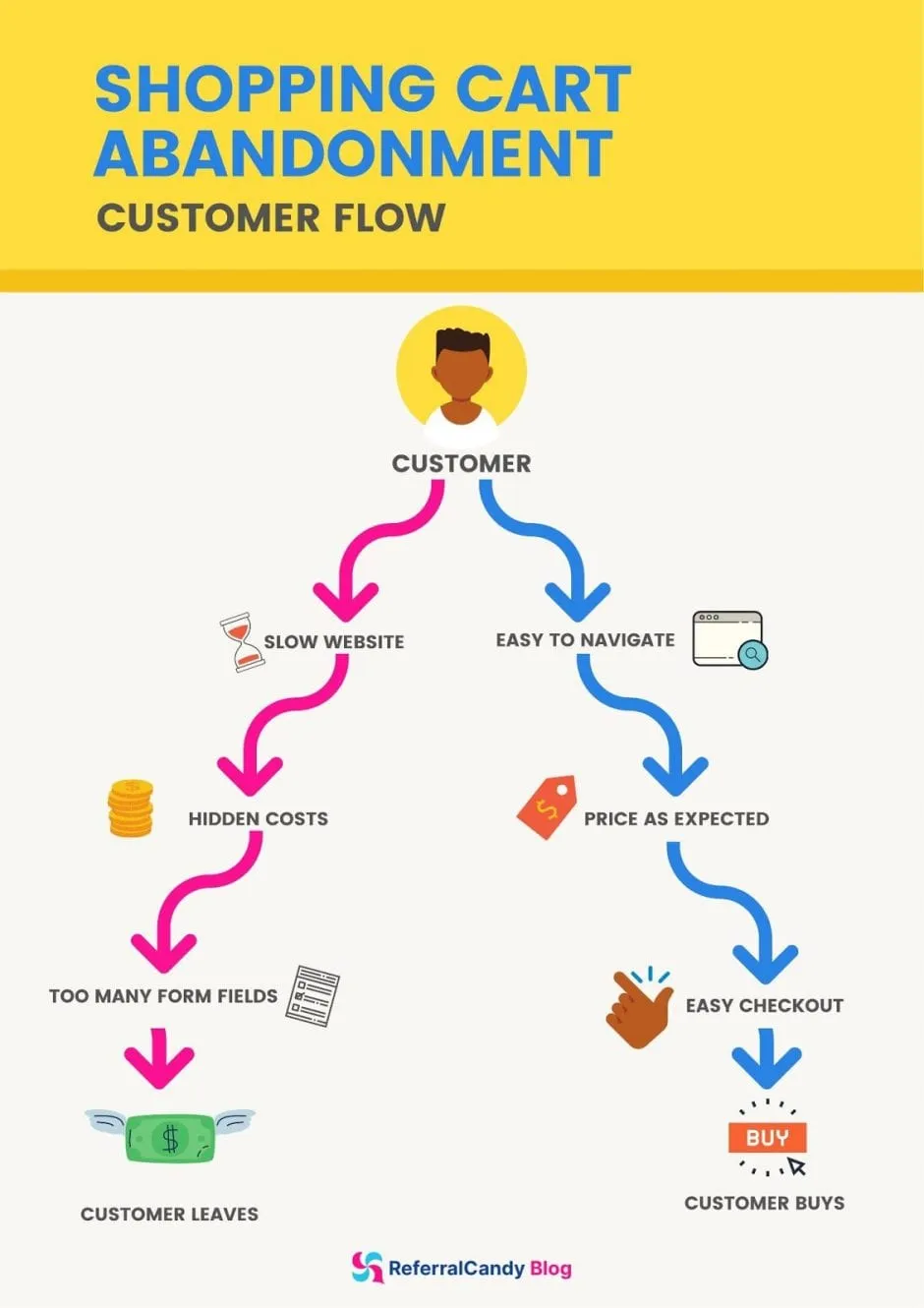
Now that you get the importance of digital shopping cart abandonment and why you should know and track your own business's abandonment rates. Let's get into how you actually do that.
(Spoiler: It's pretty simple.)
Essentially, calculating your shopping cart abandonment rates comes down to a simple percentage equation using the total number of shopping carts users have initiated on your site and the number of completed purchases.
Ready? Here it is:
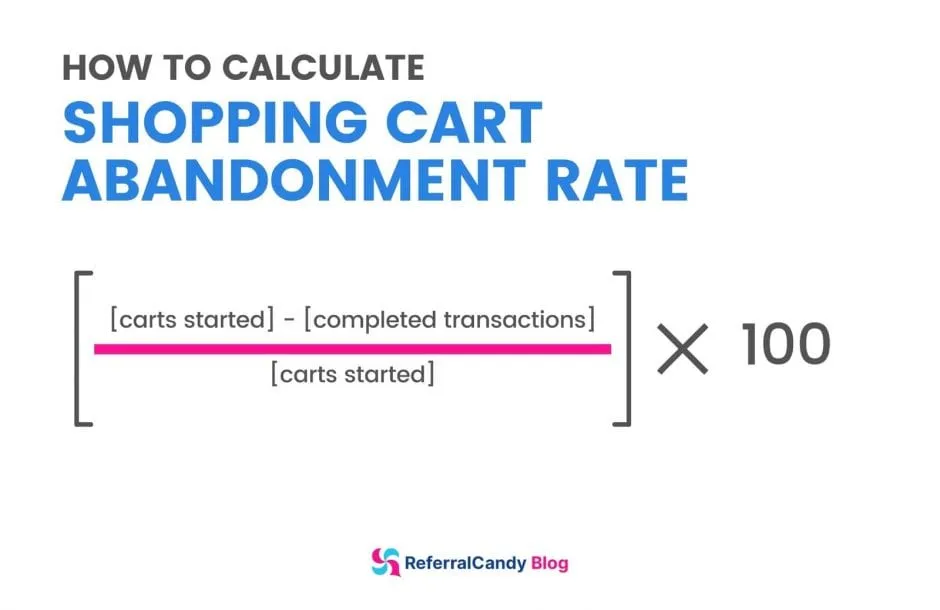
This equation basically gets the percentage of successful purchases, then finds the cart abandonment rate based on that.
For example, if your eCommerce site had 400 users start a digital shopping cart and 100 completed transactions, it would mean that you have 300 cart abandoners. 300 divided by 400 equals 0.75. Multiply that by 100 and you have your cart abandonment rate: 75%.
Once you have the abandonment rate, we can get into why it's happening and find ways to reduce cart abandonment or create a cart recovery strategy.
I already mentioned the most common reason for shopping cart abandonment: the customer wasn't ready or was just looking (AKA virtual window shopping). But that's not really something you can change. It's just going to happen regardless. There may be things you can do to help the user on their customer journey (I'll get into that later), but it's not an easy fix.
For now, let's talk about the common reasons for an abandoned cart that are easier for you to do something about.
You've probably been there: You're ready to buy something, then the total price comes up and it's way more than what you'd signed up for. Whether it's shipping costs, credit card fees, tax, or other additional fees, these can often feel like a betrayal for the online shopper.
They're thinking: "You told me one price, but now there's an extra 20 bucks – what gives?"
According to Baymard's research, if you segment out the US shoppers that abandon carts because they were just browsing, 49% of the rest of shoppers that abandon their cart do it because of extra fees. That's a whole lot of customers disappointed in hidden costs.
Sure, sometimes extra fees are unavoidable, but it might be messing with the way visitors see your business so it's something to consider when adding up fees and price.
Solution: Be Transparent
Regardless of extra fees, it's probably not a surprise that money becomes a factor. For most shoppers, price will always be something they have to consider – and you should too. While setting prices can be challenging and may feel like in this league of competition only big businesses like Amazon, Target, or Walmart need to deal with, you should absolutely be thinking about it.
We won't go into too much detail about setting prices because it's a whole other can of worms, including scraping Amazon data for example. However, if you want to get the full rundown about why pricing is important and how to create a pricing strategy, check out our blog post on eCommerce pricing intelligence.
Letting your customer create an account with your eCommerce site sounds like a great idea, right? They (and you) can get loads of added benefits! Think:
Then again, what if the customer doesn't want you to store their personal information? Maybe they just aren't ready to commit to getting an account yet. Or, if your product is more of a one-time purchase sort of thing, they may not intend to make another purchase so it just feels like a waste of time.
When you look at it that way, it's not that surprising why Baymard notes this as the third most common reason for digital shopping cart abandonment. You're likely going to get shoppers who see "you have to create an account" and immediately leave your site.
Solution: Allow Guest Checkout
Along similar lines of the issues with creating an account, forcing your shoppers to go through more form fields than they need to is another big issue.
You don't want your customer to end up thinking, "How long is this going to take? Ugh, forget it."
For example, imagine you lined up at a grocery store with a full shopping cart, but before the cashier swipes your card, you have to answer some questions. If it's just a couple of quick questions like your phone number or email, it's no problem. But if she handed you a clipboard with 50 different questions on it, you'd probably leave the cart and walk out.
Who needs food anyway.

The same thing goes for your customers if you ask them five billion questions.
Solution: Use As Few Form Fields As Possible
In Baymard's research, slow delivery was 19% of US shoppers' reason for cart abandonment (after taking out the "just browsing" option). Just like you may not be able to control shipping costs, you may not be able to offer super quick delivery. That's okay.
The key here is transparency. If you tell shoppers before they create a cart, "hey, we have 3-day shipping," or "this product is on backorder, you'll get it in three weeks," they're at least going into the checkout process with eyes open.
If the customer only finds out the delivery time while they're making a purchase, that opens the door for disappointment and checkout abandonment.
Want some advice? A service like Easyship can take care of this for you.
Solution: Be Transparent
An outdated website is more than just an eyesore – it makes your business lose credibility. The internet can be a sketchy place, and customers are thinking about that when they have to enter their credit card information.
According to FIS's Worldpay Consumer Behaviour and Payments Report, 53% of consumers are either extremely or very concerned about their private or personal data being compromised or hacked.
Solution: Provide Social Proof
Another common reason customers ditch their online shopping cart is because of website errors or malfunctions. Websites that crash, have slow load times, or lack features like eCommerce visual search can frustrate users, leaving them with online shopping cart abandonment.
In Baymard's research, it made up 12% of abandoned purchases (excluding "just browsing").
Solution: Optimize Site Speed
Online shopping creates added risk considering you don't see the product in person before buying. If the shop has a good return policy, it's not a huge deal – you can just send it back if it doesn't work out.
However, if the return or refund policy is bad or unclear, it may make shoppers think twice about completing their purchase.
Solution: Have Good Refund and Return Policies
According to a 2018 SaleCycle survey on reasons for cart abandonment in the fashion and retail industry, 6% noted payment issues. You might think that's not all that much, but it's still an important factor to consider.
You don't want your customer to be thinking, “I have to pay extra just to use my Mastercard? Ugh, forget it.” Restrictive payment options, or making customers pay extra to use other payment options will have customers thinking exactly this. A checkout process that makes payment challenging is going to have far more abandoned carts.
Solution: Allow Multiple Payment Options
For shops that have brick-and-mortar locations, customers may contribute to digital shopping cart abandonment only to go to your shop and complete their purchase in person.
This is probably the best-case scenario when it comes to eCommerce cart abandonment because you haven't actually lost any customers. SaleCycle's survey reported that 15% of abandoned carts in the fashion and retail industry were because the customer was "buying the item(s) in-store" instead.
TL;DR: Make the checkout process as easy and seamless as possible for your customers. The more barriers and surprises you have along the way, the less likely they’ll make it to the checkout finish line.
Now that you know all these reasons why the average cart abandonment rate is so high, here's the good news: you can make changes to reduce your abandoned shopping cart rate.
Most successful Shopify stores are already doing it.
Some of these ways you may have already gleaned from the points above, but here are 10 ways you can improve your business's conversion rates and make sure your customers are happy.
Transparency is key for creating a good customer experience. You want your customers to know exactly what to expect when they make a purchase on your website. This includes everything from how long the checkout flow will take to shipping time to payment type.
If you're upfront with visitors from the beginning, they'll know what to expect when dealing with the checkout process so they'll be less likely to leave the site. Make sure your customers know what the extra fees will be, how long shipping will take, and what type of payments you take. This is especially important during peak holiday periods because people are already stressed and likely looking for products to come within a certain timeframe.
Take Amazon, for example. There are many reasons why they’re the #1 ecommerce platform out there right now, and one of those reasons is that they are upfront about shipping times.
This product, for example, is usually dispatched within 2 to 4 weeks. If I were in a hurry, then I’d avoid adding this product to my cart altogether. If not, then it wouldn’t be a massive shock when it doesn’t arrive immediately, like all of the other products coming from Amazon.

To deal with the issue of a complicated checkout process, ruthlessly minimize the information you need. Baymard's large-scale checkout usability testing shows the ideal checkout flow can be as short as seven to eight form fields. If your process requires more than that, think about how you might be able to shorten it or make it simpler.
If you’re using Shopify as your ecommerce platform, then you can rely on their standard checkout process for optimal flow.
Golde, a Shopify ecommerce shop, has a beautifully simple and clean checkout process with only required form fields and easy payment options.
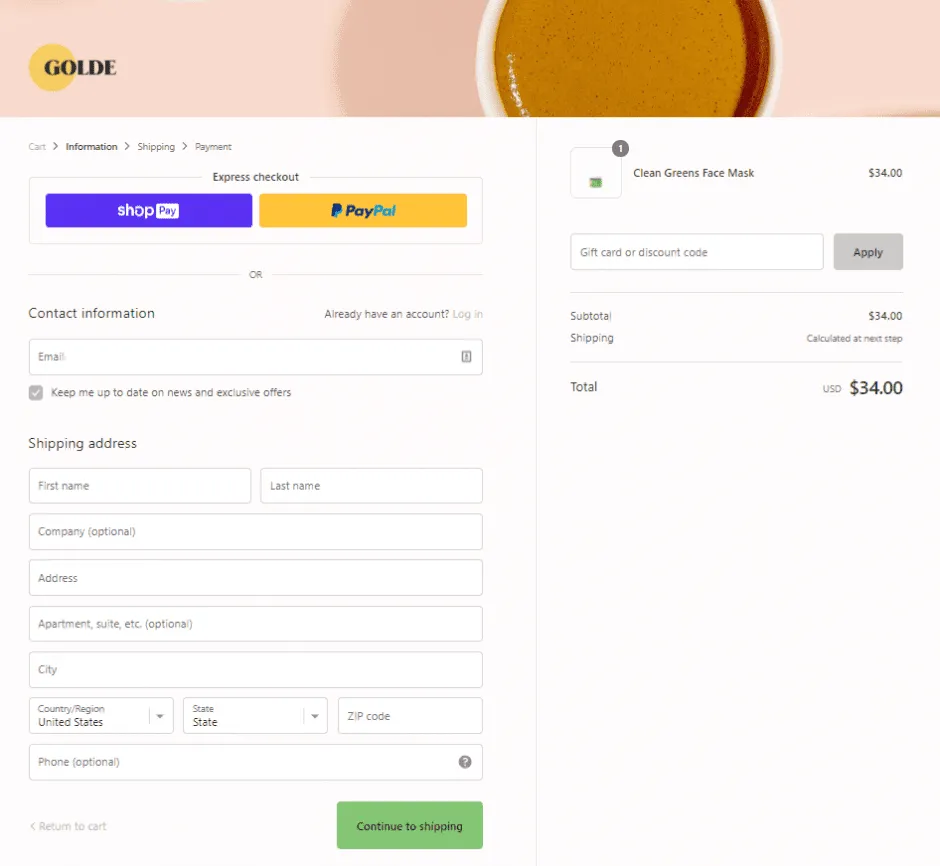
If you want to collect more customer data, you can always send a post-purchase survey to learn more about your consumers (this can also be super helpful with learning about your customers' shopping experience and general relationship marketing).
Following the same lines as transparency and fewer questions, make sure the total checkout flow is as quick and easy as possible. It's a great idea to add progress indicators to show how far along the customer is in the process so they know generally how long it will take.
Using Goldie as an example again, they’ve got a progress tracker right up top that shows you what step you’re on in the entire process.
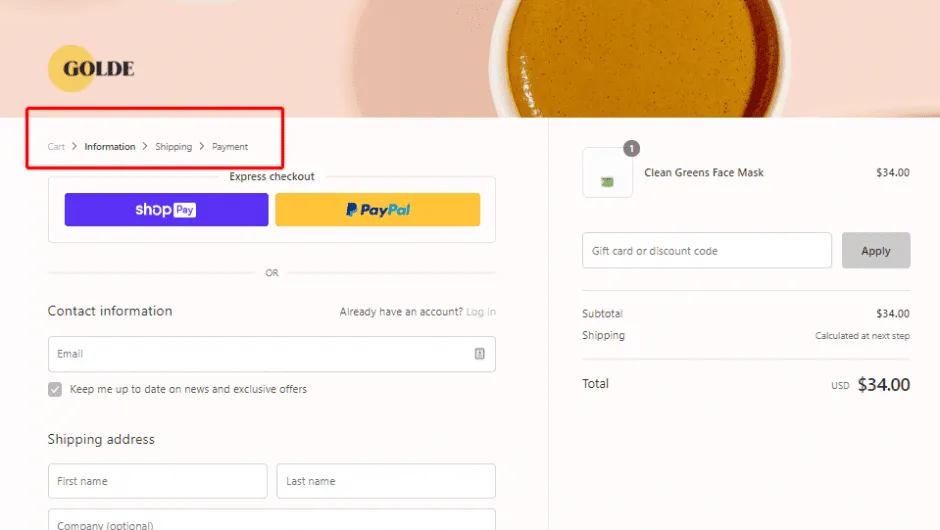
And notice that there are only four steps listed, making it quick and easy and totally predictable.
The quicker the checkout, the more likely customers will complete a purchase because they don't have to spend as much time thinking about it and don't feel like they're wasting any time.
Remember how some visitors will peace out the minute you require a login? Make it less of a deal breaker by allowing visitors to use guest checkout.
RugPadUSA, evidently also a Shopify client, offers either “Express Checkout” or the option to checkout without creating an account.
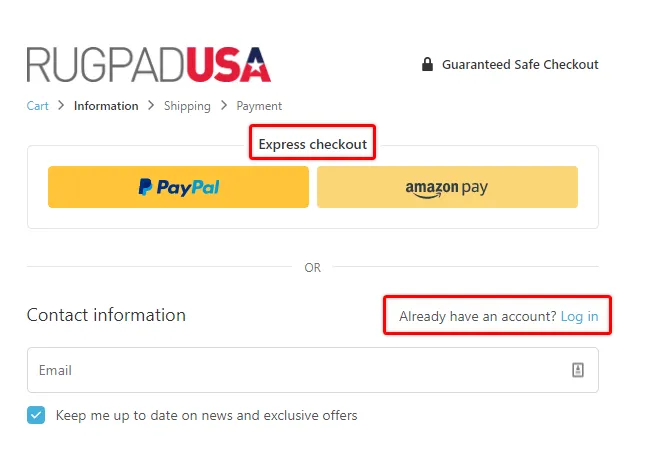
In this situation, you're doing everything you can to make it easier for the customer in the future if they do choose to sign up, but you aren't making it a requirement. This gives the customer more choice in the payment process.
If you're really keen on getting customers to make an account, you can always offer some additional incentive for creating an account such as free shipping or additional sales coupons.
If you can, try to accept multiple forms of payment and be transparent about the ones you don’t accept. The more comfortable your customers are with the payment method, the more likely they'll be to follow through.
Think PayPal, Zelle, direct deposit, credit card, debit, MasterCard, Visa, Discover, Apple Pay... I could go on. But here's the thing – if you're a small business, paying the extra fees that some of these payment options require can feel like a decent chunk of money. I totally get it.
But think of it this way: Getting 95% of a successful sale is better than getting 100% of an abandoned cart (AKA $0) right?
Take a look at Jungalow’s payment options.
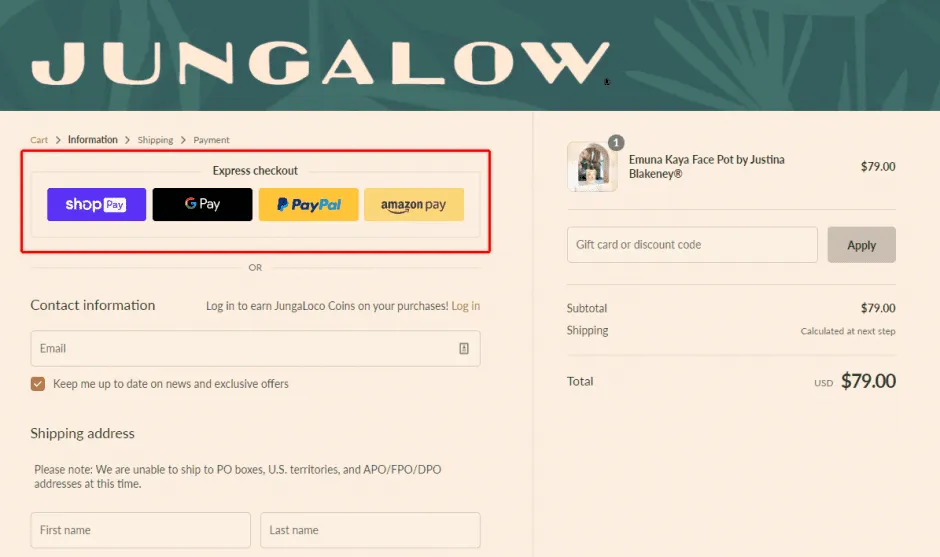
Sure, they don’t list all of their credit card options right away, but they list 4 extremely popular payment options that most customers are likely already logged into in their browsers. This makes it stupidly easy to take their money.
An exit-intent popup is a popup that appears when visitors are about to leave the site. The site will detect mouse or scroll movement (creepy right?) and when it looks like a visitor is about to leave, up pops an irresistible offer.

So how successful are these popups? It can vary a lot. Some businesses can generate up to a 20% conversion rate with their popups!
Want to learn how to ace your next exit-intent popup? Check out our 8-point checklist for the best exit-intent popup that works.
People are impatient. We like instant gratification. So is a page taking forever to load? Nope.
Don't believe me? Even a 1-second page response delay can cause a 7% reduction in conversion rates.
That's a massive chunk of visitors and if that's happening when they're getting ready to make a purchase? That's a huge risk that shoppers get distracted and abandon their carts.
The digital marketing industry calls them “rage clicks” and that is exactly what happens before the potential customer clicks out of your online shop forever.

Plus, site speed can also help with search engine optimization and other areas of your site.
If you're able to collect an email address from a cart abandoner, you might be able to recover the customer with an abandoned cart email (cart recovery email). Abandoned cart emails remind the customer that they have products waiting for them. The cart abandonment emails will then invite them back to the checkout page.
And how good are these emails? They have a killer conversion rate of 18.64%.
Want to learn more about cart recovery emails and how to create one that brings the customer back every time? Read more about the 6 components to focus on before sending an abandoned cart email.
Another obvious one, but if you haven't implemented a solid return policy yet, you may be driving potential customers away. A good refund or return policy builds trust with your customers and gives them the security they need to let you take their money.

Aside from potentially improving your shopping cart abandonment rate, returns have become huge in the eCommerce realm so if you don't have a policy for it, you're setting yourself up for disaster. Nearly 41% of shoppers purchase with the intent of returning.
So, no return policy?
Abandoned cart.
Need some support in creating a rock-solid return policy? Check out our guide to writing an eCommerce return policy.
Social proof is a huge part of marketing persuasion and it's also what might push your buyer over the finish line for making a purchase.
Picture this: your customer's sitting on their couch looking at the checkout page of your site about to buy a spiffy new backpack. They read a few positive reviews on the product page, but now they're starting to have second thoughts...
Then they see a popup at the bottom of the page saying "Janet just purchased the SuperCool Backpack!" Alright, they're in good company – Janet knows what's up. The customer now goes on to complete the purchase and your conversion rates are off the charts!
Okay, maybe it wouldn't be exactly like that, but you get the idea. Sneaking some social proof in there somehow can seriously help.
A common practice in the ecommerce world is to have your customer reviews right on your homepage. Clare, for example, has a simple banner that shares a recent review and invites the customer to see all of the other reviews.

Want to learn how to make it work for you? Check out these 26 genius social proof marketing examples you can try.
Phew! Okay, we've gone through a lot in this article, but you might still have questions - I gotchu. Here are the answers to a few common questions that many shop owners have when it comes to shopping cart abandonment.
At the most basic level, you're losing customers. One cart abandoned equals one less product sold.
On another level, depending on how you've structured your site, it could potentially mess with your supply chain. It's not super likely, but it is possible.
There are a LOT of cart abandonment stats out there that will tell you different numbers. It also varies by industry, so travel sites and automotive often have a higher rate than other industries (though not always).
However, the average cross-industry shopping cart abandonment rate that we're going with is 69.8% from Baymard Institute.
It depends on your industry, but generally, if you're below the average rate (69.8%), you're doing well.
If you want to get more specific by industry, you can look into industry-specific rates.
Johanna Flashman is a freelance writer, content marketer, and SEO strategist with a passion for connection, advocacy, and outdoor adventure. She runs an inclusive online information hub for women freelancers in the outdoor industry called The Freelance Outdoorswoman. You can find her on LinkedIn, Twitter, at johannaflashman.com, or contact her directly at jayflash0@gmail.com.
Grow your sales at a ridiculously
lower CAC.